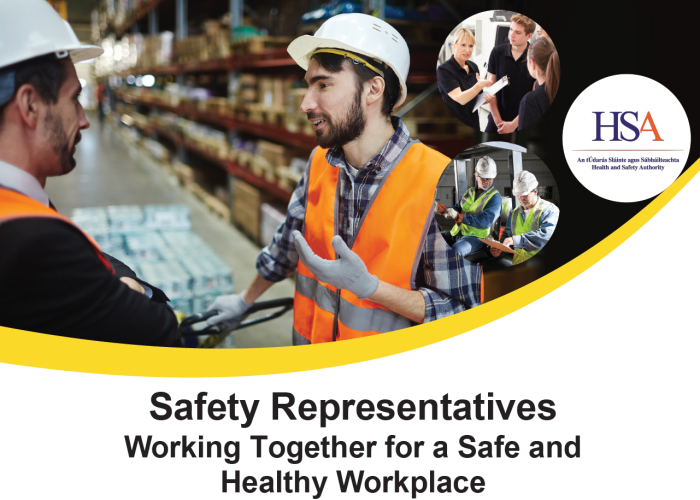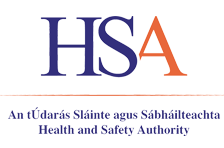Safety Representatives

A Safety Representative is an employee elected by their fellow employees, whose main role is to represent them to management on all health and safety issues. The Safety Representative provides a direct link between the employer and employees on issues that may be identified through workplace inspections or through direct communication with fellow workers.
Introduction
Well-trained Safety Representatives serve as a vital link between workers and management. Training enhances their ability to communicate effectively, interpret safety data, and represent employee concerns clearly and professionally. This collaboration fosters a culture of mutual trust and shared responsibility, and strengthens the organisation’s safety culture.
The goal of Safety Representative training is to equip Safety Representatives with the knowledge, skills, and confidence they need to effectively represent employees on health and safety matters and contribute to a safer workplace.
Safety Representatives Training and the Law
Irish law requires that Safety Representatives receive adequate training, paid for by the employer, to support their consultative role in promoting health and safety. The training should enable the Safety Representative to acquire the knowledge necessary to discharge their functions under the Act. The level of training should match the complexity of the workplace hazards and the representative’s duties.
In all sectors except for construction, the employer is legally obligated to ensure that Safety Representatives receive training. On construction sites with >20 employees, the Project Supervisor at the Construction Stage (PSCS) must ensure that Safety Representatives receive training.
Separately, employers are responsible for training Safety Representatives on the specific hazards and safe systems of work in their own workplaces.
Best Practice for Safety Representative Training
Learning Objective
The learning objective is to empower Safety Representatives as effective advocates who help bridge the gap between workers and management in creating a healthier, safer workplace.
Safety Representatives should be trained to
- Understand safety processes and legislation.
- Consult effectively with both employees and management.
- Participate in safety inspections or investigations.
- Represent employees’ safety concerns appropriately.
- Communicate effectively with managers and staff.
- Promote a positive safety culture.
Who Provides Training
Training can be provided by commercial training organisations or Trade Unions.
Trainer Profile
The trainer should have at least a basic qualification in Occupational Safety and Health (OSH). Ideally, they should also have practical experience in a Safety Representative role to ensure the training is relevant and grounded in real-world practice.
Training Syllabus and Duration
|
# |
Topic/Area |
Indicative Contents |
|
1 |
Foundations of Occupational Safety and Health |
·Overview of Occupational Health and Safety (OSH). ·Role of the Health and Safety Authority (HSA). ·The preventative approach to safety and health at work. |
|
2 |
Legal framework and legislation |
·Safety and health legal system and legislation. ·Safety consultation and employee participation. |
|
3 |
Safety Representative role |
·Role and functions of a Safety Representative. ·Communication skills for Safety Representatives. ·Representing employees on health and safety issues. ·Engaging employees in safety awareness initiatives. ·Safety promotion. ·Inclusion of vulnerable workers. |
|
4 |
Risk-control and safety and health management at work |
·Hazard identification and carrying out risk assessments. ·Purpose of a Safety Statement. ·Carrying out inspections. ·Accident investigations. |
|
5 |
Safety culture and safety leadership. |
|
|
6 |
Safety performance evaluation |
·Reactive and active monitoring. ·Leading and lagging indicators. |
|
7 |
Information & resources |
·Sources of safety and health information. ·HSA resources and tools. |
The level of detail provided on each topic will depend on the size, level of risk, degree of complexity and level of development of the safety and health management in the workplace. The law does not specify how long Safety Representatives training should be, but good practice is to provide between three to five days of training. Even for lower-risk workplaces, the training course should last at least three days, with practical sessions to demonstrate the issues under study.
Class Size and Delivery Format
Training can be delivered online, in person (face-to-face), or through a blended format combining both methods. To ensure effective learning and interaction, class sizes should be limited to no more than 20 participants. Training should include both theory and practical exercises. The training should include informal discussions and group activities.
Assessment & Certification
Assessment is not mandatory. However, it is considered good practice to include a short test or multiple-choice questionnaire (MCQ) at the end of the course. This helps reinforce learning, check understanding, and provide feedback to learners.
Learners should receive a certificate for attending the training.
Initial and Recurrent Training
Safety Representatives should receive initial and refresher training. The law does not specify how frequently refresher training should be, but good practice is about every three years.
Peer Learning
Safety Representatives should be encouraged to support and learn from one another—both within their own organisation (past and present) and from others in the wider sector. Learning from fellow Safety Representatives helps share knowledge, solve problems faster, and encourage teamwork across departments. By sharing real-life experiences and practical tips, they gain a deeper understanding of safety that goes beyond formal training.
Experienced Safety Representatives should mentor newer ones, sharing lessons from past incidents and practical knowledge. This builds confidence and accelerates learning beyond formal training.
In large organisations, Safety Representatives from different departments meet regularly to share concerns, review incidents, and propose safety initiatives. This promotes cross-functional learning and empowers employees to shape safety culture.
It is important to create safe spaces for discussion—both formal (Safety Committees) and informal (coffee chats).
If workers see their company making progress on promoting safety and health, they will be motivated to do more to ensure compliance. The best way to engage workers to follow safe work procedures is to get them involved in the development and review of those procedures. It is important that worker's opinions are valued and considered, and for them to be included in the implementation of health and safety measures in the workplace. After all it is the workers who are doing the jobs and they will have valuable insights to offer.
Employees can elect, select and appoint their Safety Representative or, by agreement with their employer, select more than one Safety Representative. The number of Safety Representatives should be proportionate to the size of the workplace, and should ensure, diverse work activities, departments or specialised occupations are represented. The person(s) selected as a Safety Representative can represent their colleagues in consultations with their employer on matters of safety, health and welfare at their workplace.
On construction sites where more than 20 persons are employed at any one time on a construction site, the project supervisor for the construction stage (PSCS) must facilitate the appointment of a Safety Representative.
Safety Representatives have rights, but they carry no duties, responsibilities or liability for health and safety in the workplace over and above that of any other employee. They are not Safety Officers.
Overall function
A Safety Representative may consult with, and make representations to, the employer on safety, health and welfare matters relating to the employees in the workplace. The employer must consider these representations, and act on them if necessary.
Carrying out inspections
Safety Representatives, after giving reasonable notice to the employer, have the right to inspect the whole or part of a workplace that they represent at a frequency or on a schedule agreed between them and the employer.
Carrying out investigations
A Safety Representative may investigate accidents and dangerous occurrences in the workplace to find out the causes and help identify any necessary remedial or preventive measures and may make written or verbal representations to HSA inspectors. However, a Safety Representative must not interfere with anything at the scene of an accident.
Other Duties
A Safety Representative may also:
- make representations to the employer on safety, health and welfare at the workplace;
- receive advice and information from inspectors in relation to safety, health and welfare at the workplace;
- make verbal or written representations to inspectors, including about the investigation of accidents or dangerous occurrences;
- accompany a Health and Safety Authority inspector carrying out an inspection at the discretion of the inspector, and where an employee concerned so requests, be present when the inspector interviews the employee about an accident or dangerous occurrence at the workplace; and
- consult and liaise with other Safety Representatives appointed in the same workplace, whether or not they work in the same place or in different places under the control of the employer or at different times at the workplace (for example, safety representatives on different shifts).
- the employer must consult the Safety Representative in advance of workplace changes which can potentially impact on health and safety in the workplace.

A properly informed Safety Representative can play an important role in preventing accidents and ill-health, it is in the employer’s interest to ensure that Safety Representatives are supplied with all relevant information.
Safety Representatives must have access to information on:
- any risk assessments and safety statement relating to their place of work;
- reportable accidents, occupational illnesses and dangerous occurrences without identifying any individual;
- on safety and health measures required under safety and health legislation; and
- any safety and health information on dangerous equipment, chemicals or processes used at their workplace including instruction manuals and safety data sheets.
A properly informed Safety Representative can play an important role in preventing accidents and ill-health, it is in the employer’s interest to ensure that safety Representatives are supplied with all relevant information.
The Authority has provided more detailed information on the role of the Safety Representative and it is set out in the publications listed below.
















